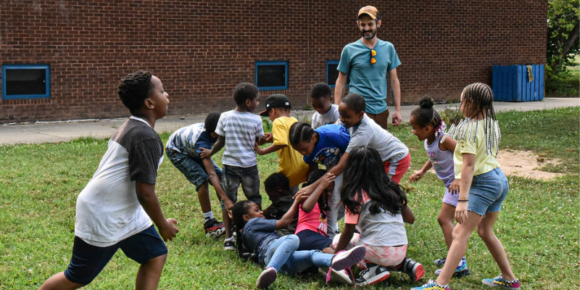Marbles and Molecules: Play-based Summer Learning Works
“Children are our future” is an old adage because it’s true. And like the exclamation “tag, you’re it!” during a game of tag, it will continue to be said for generations to come.
Adults are not just responsible for passing on a livable world; we’re also responsible for passing on knowledge, compassion, and wisdom, so our children know how the world works and how to protect it.
When it comes to teaching about the environment and the challenges we face, hefty textbooks and jam-packed lesson plans aren’t always the answer; in fact, for younger age levels, they most definitely are not. Often times, the best way to teach is through allowing kids to be kids.
This summer, I participated in SummerREADS, a program for Baltimore City K-5 students run by Young Audiences of Maryland; and through it, I taught students from 11 different public schools about how they are connected to our waterways.
[modula id=”22026″]
Marbles: making sewage less boring
My first goal was to teach the basics of the water cycle. To do this I used some hot and cold water, a few hand signals, and a couple of drawings. My second goal — teaching about Baltimore’s urban water cycle — was more challenging. A classic marble run game proved to be the answer.
Using two separate marble runs, I built 3D marble paths representing Baltimore’s stormwater and sanitary sewer systems. By using different colored marbles — blue marbles for rain, black for oil, green for sewage, and so on — students were able to see how more than just water flows through our pipes.
I also balled up bits of paper to show how the pipes can get clogged with trash and F.O.G. (fats, oils, and grease), and how such nasty things ultimately end up in our rivers and harbor. The look on the kids’ faces was priceless.
Tag, you’re precipitation!
To end the lesson we played a water cycle tag game outside. One student was deemed the “sun beam,” three more held hands in a ring to form a “cloud,” and the rest of the students were designated “water molecules” in the air. The “molecule” kids would scatter, and were chased until tagged by the “sun beam,” at which point they had to stand in the middle of the ring made by the “cloud.”
Eventually, and with many squeals and giggles, the cloud would get too full of “molecules,” causing the cloud to break and children to scatter back out into the field screaming “precipitation!” in unison.

My favorite part of the lesson was seeing students when the lesson clicked. The most memorable “aha” moment was seeing everyone’s grossed-out faces when they understood where dog poop goes when it’s not picked up. On the last day of SummerREADS, I even saw a student stop playing water cycle tag to school another student for dropping a snack wrapper. “Don’t you know that’s gonna go to the harbor?!”
Fun and games won’t directly restore our waterways, but play-based learning and letting kids be kids is definitely part of the solution. Using marbles and tag is helping to get kids interested in our waterways and water systems. Getting them interested will get them to care.
Remember: we’re all responsible for raising the next generation of environmental stewards — so to my fellow adults reading this post… tag, you’re it!
_____________________________
John Marra is an Ecoliteracy & Restoration Specialist at Blue Water Baltimore. From green infrastructure and storm drain art to school trips and ecoliteracy workshops, Marra values the power of engaging communities for lasting change.
To learn more about our education and ecoliteracy programs, click here.

